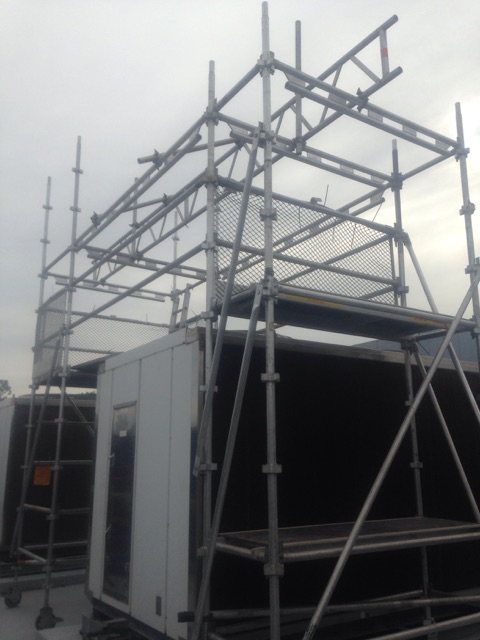Mr Scaffold recently took part in a project to swap out the fan motor on one of the cooling systems for a Datacentre.
According to Wikipedia:
 “IT operations are a crucial aspect of most organizational operations around the world. One of the main concerns is business continuity; companies rely on their information systems to run their operations. If a system becomes unavailable, company operations may be impaired or stopped completely. It is necessary to provide a reliable infrastructure for IT operations, in order to minimize any chance of disruption. Information security is also a concern, and for this reason a data center has to offer a secure environment which minimizes the chances of a security breach. A data center must therefore keep high standards for assuring the integrity and functionality of its hosted computer environment. This is accomplished through redundancy of mechanical cooling and power systems (including emergency backup power generators) serving the data center along with fiber optic cables.”
“IT operations are a crucial aspect of most organizational operations around the world. One of the main concerns is business continuity; companies rely on their information systems to run their operations. If a system becomes unavailable, company operations may be impaired or stopped completely. It is necessary to provide a reliable infrastructure for IT operations, in order to minimize any chance of disruption. Information security is also a concern, and for this reason a data center has to offer a secure environment which minimizes the chances of a security breach. A data center must therefore keep high standards for assuring the integrity and functionality of its hosted computer environment. This is accomplished through redundancy of mechanical cooling and power systems (including emergency backup power generators) serving the data center along with fiber optic cables.”
It is obvious from the above, that “mechanical cooling” is an essential component of the makeup for any datacentre. Speed and Precision were required to erect the scaffold, allow the operation for the swap-out of the fan motor, and then dismantle the scaffold within a timely manner without compromising the security or operations of the centre.
Aluminium scaffold was perfect for the operation, it’s lighter weight, with more than sufficient strength would enable a faster build and dismantle. As can be seen in the photos, two double braced single width (0.7m) towers were erected with wheels. Using the wheel adjustments, each was raised slightly so the platforms were at the perfect level just above 2 metres. A further 1.2 metres above the platforms, ledger beams were placed along the length of the mobiles.
 The two towers were then joined by more ledger beams at the outer edges, and a layher beam positioned vertically supported by the twin ledger beams on the mobile towers. The whole structure could then be used as both a work platform for accessing the top of the fan mounting structure, and a form or gantry crane for hoisting and moving both the old and new fans to an from the equipment.
The two towers were then joined by more ledger beams at the outer edges, and a layher beam positioned vertically supported by the twin ledger beams on the mobile towers. The whole structure could then be used as both a work platform for accessing the top of the fan mounting structure, and a form or gantry crane for hoisting and moving both the old and new fans to an from the equipment.
The tower that was to be used as a work platform was correctly protected by use of an internal ladder, handrails and toeboards coupled with mesh screens on the outer facing edges. The Toeboard and screens are important in any situation, as they prevent tools and equipment from accidentally being dropped, kicked or bumped off the work platform and contacting anybody at a lower level. Here there would be personnel working below in preparing the new installation, and removing the old fan motor.
It should be noted that although this build was specifically created to be mobile, whenever a worker was mounted on the scaffold, all wheels had brakes applied and the structure was stationary. No mobile scaffold is safe to be moved whilst a person is mounted on the structure.

